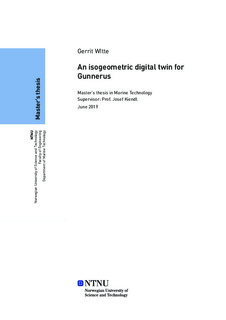| dc.description.abstract | Isogeometric analysis (IGA) is a new approach in the world of Finite Element Analysis (FEA). The idea is to merge the Computer Aided Design (CAD) model directly into FEA. This was not possible until now due to different basis functions in CAD model and the FEA model. After introducing IGA in 2005 by Hughes etg al., a lot of research improved the approach, which is why the idea came up to combine IGA with a digital twin. A digital twin is a digital representation of a physical structure, which is updated all the time and fed with information from the physical twin. Updates can be structural changes, cracks in the structure or a swap of parts. In this field IGA will increase the efficiency of the workflow, since the updated digital twin can be directly used for structural analysis. Digital twin will be a key technology for the upcoming Industry 4.0 and therefore the importance and usage of digital twin will increase.
Abstract To analyse a big structure, such as a digital twin, the existing implementation needs some improvements in regards to efficiency.
Abstract After describing the mathematical background of NURBS and the state of the art of IGA, different approaches are discussed to improve the efficiency and extend the existing code. Knot removal, neglecting small trimmed areas and polynomial degree for integration are discussed. Especially neglecting of small trimmed areas shows good improvements regarding the condition of the stiffness matrix. A value of 1% for the ratio between trimmed area and element area seems to be a good value, which is proved by different geometries. Further the import of IGES files was updated to read in multiple patches and the plotting of trimmed surfaces in physical space to plot multiple patches trimmed patches.
Abstract The work with the digital twin of ‘Gunnerus’ shows some problems with the digital twin itself and with the existing IGA code. The digital twin consists of to many single patches to couple every patch by hand and the thickness of every plate is lost. Therefore only small areas of ‘Gunnerus’ are modelled. On the other hand is that the existing element cases for trimmed elements are not sufficient. Tests with ‘Gunnerus’ have shown that there are trimming lines on the boundary and cuts through two vortex points of one element. This case is not covered by the existing one. This is not within the scope of this thesis and needs further research. | |
